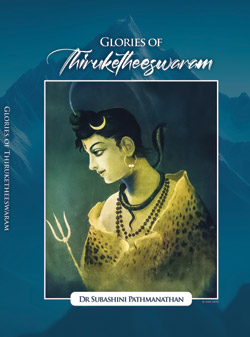Insightful depiction of an ancient Hindu temple
View(s):This long-overdue endeavour of writing a book on the sacred Thiruketheeswaram Temple in English provides non-Hindus with a unique opportunity to explore the historical and spiritual significance of this revered site. The monumental task was entrusted to the erudite Dr. Subashini Pathmanathan, the idea conceived by Managing Director of Ceylon Express Newspapers (Pvt) Ltd, Mr. Kumar Nadesan. The book was funded by Mrs. Abiramy Kailasapillai, Chairperson of the All Ceylon Hindu Congress from her personal resources.
 The author meticulously covers nearly all historic and divine aspects of Thiruketheeswaram temple, focusing particularly on Saiva Tamil traditions and the temple’s rich cultural background. A standout feature of the book is the author’s use of colour photographs and graphic art to substantiate her interpretations, enhancing the reader’s understanding. The book’s well-structured format across 15 chapters gives a vivid, documentary-style literary presentation. Thiruketheeswaram, an ancient Hindu temple located in Manthotam within the Mannar District, holds immense historical and spiritual significance. Historians note that it was here that Kethu Bhagavan worshipped Lord Shiva, a fact that contributed to the temple’s name, Thiruketheeswaram. Many of us not aware of the fact that Thiruketheeswaram was one of the five recognized Eswarams of God Shiva in Sri Lanka long before the arrival of King Vijaya in 600 BC.
The author meticulously covers nearly all historic and divine aspects of Thiruketheeswaram temple, focusing particularly on Saiva Tamil traditions and the temple’s rich cultural background. A standout feature of the book is the author’s use of colour photographs and graphic art to substantiate her interpretations, enhancing the reader’s understanding. The book’s well-structured format across 15 chapters gives a vivid, documentary-style literary presentation. Thiruketheeswaram, an ancient Hindu temple located in Manthotam within the Mannar District, holds immense historical and spiritual significance. Historians note that it was here that Kethu Bhagavan worshipped Lord Shiva, a fact that contributed to the temple’s name, Thiruketheeswaram. Many of us not aware of the fact that Thiruketheeswaram was one of the five recognized Eswarams of God Shiva in Sri Lanka long before the arrival of King Vijaya in 600 BC.
The author elaborates on the divine attributes of Lord Shiva, highlighting the religious significance of poojas, rituals, and worship methodologies in Shiva temples across various regions of Sri Lanka. The historical significance of these temples is underscored with particular attention to the seaport of Mathotam, which served as a hub for trade activities, including imports, exports and other commercial exchanges in ancient times. Additionally, the book emphasizes the importance of the Palavi Pond, an integral part of the Thirukethesewaram temple.
The archaeological and historical aspects of the temple are of considerable significance. The surrounding area holds numerous archaeological artefacts, many of which remain submerged.
The book provides a detailed account of the Shivananda Gurukulam associated with the sacred temple, as traced from ancient Ola leaves.
The middle section of the book elaborates precisely on how this temple managed its affairs during the height of war, including transport facilities for devotees and how temple poojas were carried out under difficult circumstances.
The book also addresses the current condition of the temple. It describes the eastern entrance, through which devotees enter up to the sacred flagpole, Nandesewarar, the sacred Mulastanam—the temple’s key location—Artha Mandapam, and Maha Mandapam, where the sacred presence of goddess Gowriswarary Ammal is felt. The interior design structures (Koshta) and the detailed layout of the inner roadway through the southern, northern, and eastern ends up to the western side are well-documented with graphic interpretations.
The author has also traced the efforts of Srila Shri Arumuganavalar, a pioneer in reviving the Saiva doctrine and Tamil culture and traditions. The prominent roles played by the South Indian Natukotai community in the development and maintenance of Thirukethesewaram during critical periods are also highlighted.
The book also addresses the rehabilitation and reconstruction of the temple following the thirty-year civil war, which inflicted substantial damage to the temple’s surroundings. The generous support provided by the Indian government for the temple’s reconstruction and rehabilitation is duly highlighted.
The religious and historical significance of Thirukethesewaram is also meticulously detailed. Two Saiva Nayanmars – Thirugnanasampathar Nayanar and Suntharamoorthy Nayanar, composed numerous Thevarams under various titles, praising the divine presence of Lord Shiva in this sacred temple. The author’s meticulous translation of these Thevarams into English is an outstanding feature of this book, showcasing her profound knowledge of the subject.
In general, sacred shrines are celebrated through festivals and events that establish their cultural and spiritual significance. The book details the various religious festivals and events that take place in Thiruketheeswaram temple, their religious importance and deeper meaning, while emphasizing the need to make devotees aware of the principles and meanings behind these festivals and events. The author has also highlighted the religious principles behind Lord Shiva’s dance by Nataraj, and interpreted the 108 dance postures and their significance, presenting them with meaningful pictures and graphics.
Overall, Dr. Subashini Pathmanathan’s work is highly commendable, offering a valuable contribution to the world of Hindus and Saivites.
| Book facts | |
| Glories of Thiruketheeswaran by Dr. Subashini Pathmanathan Reviewed by P. Kunchithapathan |
Searching for an ideal partner? Find your soul mate on Hitad.lk, Sri Lanka's favourite marriage proposals page. With Hitad.lk matrimonial advertisements you have access to thousands of ads from potential suitors who are looking for someone just like you.


